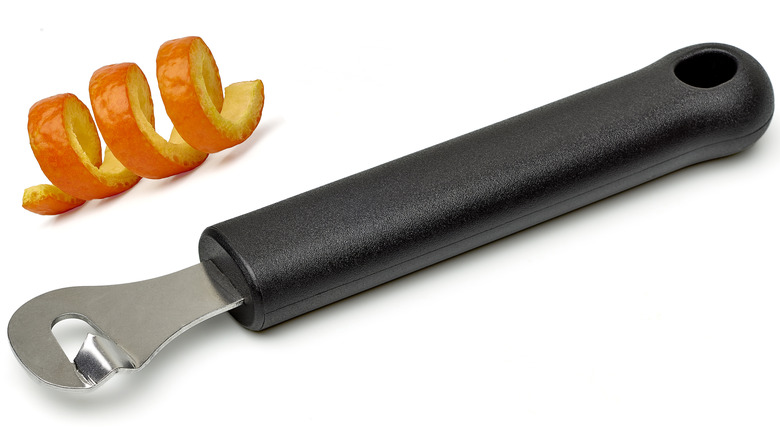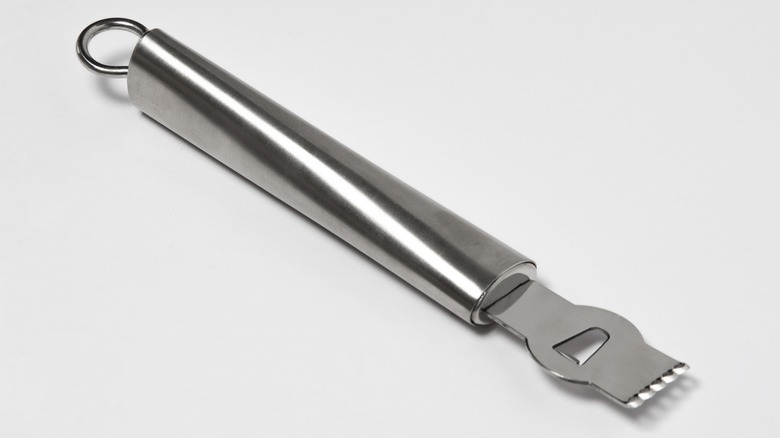The Specialty Knife You Need To Elevate Your Cocktail Game
Martini lovers who prefer to garnish their cocktails with a twist of lemon know that there's a big difference between a slice of lemon and a true twist of lemon zest, even though they're sometimes served interchangeably. While both garnishes deliver lots of lemon flavor, a slice with the fruit attached introduces some lemon juice to a drink, while a properly cut piece of the lemon peel adds only the lemon zest for essence. Without the right tool, however, it's not so easy to peel a perfect twist from a whole lemon, which is why a twist-request is often fulfilled with a whole lemon slice or even a slice with the fruit peeled off.
In this day and age of high-quality cocktails, there's no need for such shortcuts. A proper twist of citrus is easy to achieve if you have the proper tool — a channel knife. If you want to bring a level of cocktail excellence to your home bar, get a channel knife of your own. They're inexpensive, easy to use, and your homemade drinks will look super professional. Also, once you pull your first proper twist from a ripe, fresh lemon, you'll never go back to serving slices.
What exactly is a channel knife?
Today's bartenders use lots of fancy tools to make specialty cocktails, from offset tweezers for placing delicate garnishes to special jiggers for measuring spirits. You don't necessarily need to know the difference between cobbler and Boston cocktail shakers to make a decent drink at home, but a channel knife probably should be standard.
Channel knives don't actually look like knives. They're hand-held tools that have a flat head with a V-shaped notch in the center for digging into the peel of a citrus fruit and separating out pith-free strips of zest. They're most often sold either in a single-blade style with just the channel notch or as a dual-use tool that has angled holes on the top for creating thin peels of zest.
They're very easy to use. All you have to do is hold your piece of citrus in your non-dominant hand. (So, if you're right-handed, hold the fruit in your left hand.) Then, holding the channel knife in your dominant hand, press the notch of the channel knife into the fruit peel and pull it across the surface horizontally (as opposed to top-to-bottom). As a result, the zest will come out at the top of the tool.
You can make your twists as long or short as you want. It might just take some practice. Start toward the top of your fruit (or vegetable) and pull your knife in a spiral, turning the produce in your hand around at the same time.
Channel knives have many uses
Channel knives are most often used for peeling strips of lemon twists, mostly because lemons are so often used in cocktails. These tools work just as well on any kind of citrus, however, so try experimenting with oranges, limes, grapefruits, and pomelos to discover different flavor profiles for garnishing your drinks. You can also use your channel knife for cutting strips of any soft fruit or vegetable, like cucumbers, celery, carrots, or beets.
You don't have to use your channel knife strictly for fresh cocktail garnishes, either. French chefs use them for "garde-manger," which refers to the prepping of cold foods such as fish, meat, and salads. Channel knives are great for harvesting thick strips of zest that you can use in recipes for marmalade or preserves. Alternatively, you can use those strips to make candied lemon zest, which works as a garnish for cocktails as well as desserts. You can also use your knife for making fun veggie-garnishes in salads and soups, or for creating fun shapes – like smiley faces — using veggies in bento boxes. Once you get the hang of using your channel knife, you'll start looking at all your produce with a bartender's eye.


